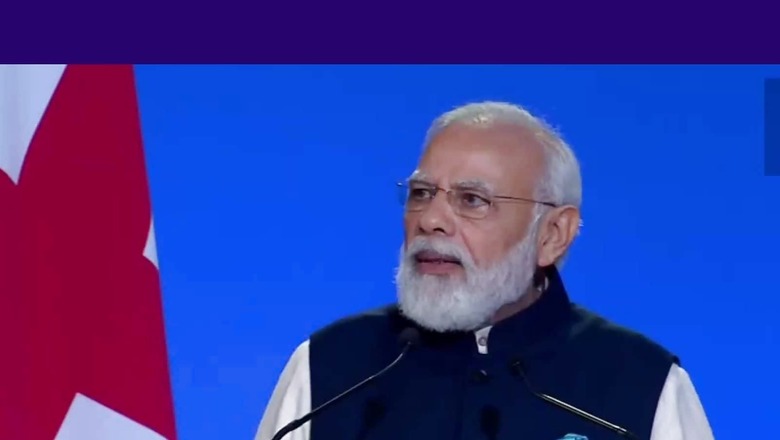
views
With the Indian leaders liberally commenting over the weeks preceding COP26 on the demerits of the newly enunciated proposal of attaining carbon neutrality by 2050, India had come to have the potential of a party-pooper. However, Prime Minister Narendra Modi — at first through his demonstrated on-stage comradeship and light bantering with several influential world leaders, and later, his bold stand on pro-climate mitigation measures managed to take the centre-stage. His stated new position on behalf of India of various short-term ambitions while postponing the net zero emission status to 2070 is expected to cause polarisation in the subsequent statements of 196 participating nations.
In stating India’s stand on the existential threat of climate change, Modi was frank as well as forward looking. He chose to carefully build upon the already agreed principle of Common but Differentiated Responsibility (CBDR) and reminded the leaders of affluent nations about their historical responsibility, their dismal and continuing record of high greenhouse gas (GHG) emissions and their failed assurances of material help to developing nations in undertaking mitigation-measures.
Suo motu, he announced the enhanced nationally declared contributions (NDCs) which included carbon-neutrality by 2070, and not 2050. While suggesting to the rich to set up a climate fund with a corpus of $1 trillion (instead of extending a paltry $100 billion a year financing from 2023 onwards), he demonstrated his leadership mettle by telling the 120 heads of government present that henceforth climate justice, equity and fairness be the cornerstone of the world’s fight against climate change and not hollow promises made in high decibels.
The revised Indian stand is both unique and challenging. It promises to reduce by 2030, its aggregate greenhouse gas emissions (GHGs) by one billion tonnes from the existing quantum; raise the non-fossil fuel capacity from the earlier 450 GW to 500 GW with such electricity, constituting 50 percent of the total consumption in 2030; reducing carbon to GDP intensity by 45 percent from the 2005 levels instead of the earlier indicated 33-35 percent; making the state-run Indian Railways a net zero emitter of GRGs by 2030 and the entire country, carbon neutral by 2070.
The 20-year longer time framework for the net zero emission status is premised on the country’s present low per capita income (one-third of global average) and the moderate annual emissions of 1.9 metric tonnes per person against the world average of 4.72 metric tonnes and the US’ 16.06 metric tonnes and China’s 7.1 metric tonnes. Going forward, with its process of development, India needs time as well as more.
It has been explicitly suggested to the G7 and other high-income nations to put their money where their mouth is. In the days ahead, they should expect terse reminders to this effect by almost every developing country. Also, a common refrain would be that the annual $100 billion financial aid included in the 2015 Paris Agreement is grossly inadequate and must be increased several fold. Though no precise global data is available, the 100-odd developing nations would need several trillion dollars of climate finance to meet their NDCs for 2030. For its less ambitious 2015 plans, the Indian requirement alone was estimated at $1.3 trillion.
In accepting 2070 to become fully carbon neutral, Prime Minister Modi went along the lines suggested by the Indian think tank Centre for Energy, Environment and Water (CEEW). Its research is rightly based on the premise that the Indian CO2 emissions have yet to peak and the earliest maximisation would be by 2040. Thereafter, 30-odd years would be needed to reach the net zero status. That appears reasonable since given the high Indian dependence on a single fuel, the ‘demise of coal’ is not imminent even if all the older and high emitting stations are gradually shut down. There would still be need in 2050 and beyond for the more efficient and less polluting coal fired capacity of almost 200 GW, i.e. almost of the same order as at present. In fact, to meet the growing electricity demand, Central Electricity Authority estimates a 1,400 GW installed capacity. In 2050, several of the recently set up super critical thermal stations would still be operational. Alongside till 2030 India would need to add more such stations, though it is imperative that only the hi-tech ultra-critical stations are established. Also, beyond 2030, washed coal use for power generation needs to be prescribed.
A precondition for such a situation is the early vacation of adequate global carbon space by the richer nations and others not heavily dependent upon a single fuel. Emissions of most have already ‘peaked’ in the 1990s and the first decade of the current century, and they are well positioned to become carbon neutral earlier than 2050.
At COP26, they should be strongly urged by the developing and middle income countries like India, China, Russia, Brazil and Argentina to advance carbon-neutrality to 2030. For those of them who are a single fossil fuel dependent, 2040 could be a realistic year. For India to make its rail system fully neutral by 2030 is feasible, though significantly higher spending on track electrification combined with greater generation and deployment of renewables would be required.
The other objective of India to step up the non-fossil-based capacity by 50 GW to 500 GW is laudable. It would, however, call for greater determination and resource-application in generation as well transmission. The pace of renewables’ accretion would need to be enhanced by a factor of 3 from the existing 10 GW. About 15GW annually would have to come from hydro, biomass and nuclear. A higher share of renewables, which have high intermittency in their generation, ipso facto, calls for frequently installing, at short distances, large-sized battery capacities in the transmission system. Apart from the technological, size and weight-related deficiencies of the currently available batteries, about $200 billion worth of investment would be needed.
Also, a high degree of ambition is attached to the target of attaining 45 per cent reduction in GDP intensity of electricity by 2030. Certainly, since 2005, the base year for comparison, energy-efficiency has tremendously improved globally as well as in India. Consistent progress in it for the rest of the century and 2030 in the context of commitments at COP is warranted to meaningfully reduce the overall energy consumption and to raise the share of the clean fuels in the overall figure.
The challenges are not necessarily insurmountable. The rampant ingenuity of its citizens and making of conditions for their greater involvement can make India play its due and legitimate part, both in the short and the long terms, in checking the onslaught of climate change.
The author is a former Union Secretary who has had a long association with the Indian power industry. The views expressed in this article are those of the author and do not represent the stand of this publication.
Read all the Latest Opinions here




















Comments
0 comment